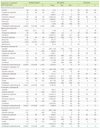Abstract
Background
β-lactam antibiotics are one of the most common antimicrobial agents. However, the increasing of β-lactamase-producing bacteria makes these agents less useful. Therefore, agents stable for β-lactamase have been developed. This study was conducted to determine the activities of the combination agent ceftriaxone-sulbactam and to compare its activities with other agents.
Methods
A total of 437 clinical isolates of aerobic and anaerobic bacteria were collected in Severance Hospital from 2007 to 2011. Using 23 antimicrobial agents, antimicrobial susceptibility tests were performed using the Clinical and Laboratory Standards Institute (CLSI) agar dilution method.
Results
The minimal inhibitory concentrations (MICs) of ceftriaxone and ceftriaxone-sulbactam were similar to or lower than those of other β-lactam antibiotics for methicillin-susceptible Staphylococcus aureus (MSSA), Streptococcus pneumoniae, S. pyogenes, and viridans group streptococci. For Moraxella catarrhalis, Neisseria gonorrhoeae, Haemophilus influenzae, and H. parainfluenzae, ceftriaxone and the ceftriaxone-sulbactam combination also show low MIC50 and MIC90. For extended-spectrum β-lactamase (ESBL)-producing E. coli, the MICs of ceftriaxone-sulbactam were lower than those of other cephalosporins. Among the anaerobes, ceftriaxone-sulbactam showed good activity compared to ceftriaxone alone for the Bacteroides fragilis group, B. thetaiotaomicron, other Bacteroides sp., Prevotella sp., and Porphyromonas sp.
Conclusions
Ceftriaxone-sulbactam showed good antimicrobial activity and thus is useful for the treatment of infections by MSSA, S. pneumoniae, S. pyogenes, viridans group streptococci, M. catarrhalis, N. gonorrhoeae, H. influenzae, H. parainfluenzae, E. coli, and K. pneumoniae, B. fragilis group, B. thetaiotaomicron, other Bacteroides sp., Prevotella sp., and Porphyromonas sp.
Figures and Tables
Table 1
Antimicrobial activity of ceftriaxone-sulbactam compared with other comparators against aerobic Gram-positive cocci

Table 2
Antimicrobial activity of ceftriaxone-sulbactam compared with other comparators against aerobic Gram-negative coccobacilli or diplococci

Table 3
Antimicrobial activity of ceftriaxone-sulbactam compared with other comparators against Enterobacteriaceae

References
1. Livermore DM. β-Lactamases in laboratory and clinical resistance. Clin Microbiol Rev. 1995. 8:557–584.
2. Nordmann P. Trends in β-lactam resistance among Enterobacteriaceae. Clin Infect Dis. 1998. 27:Suppl 1. S100–S106.

3. Moellering RC Jr. Meeting the challenges of β-lactamases. J Antimicrob Chemother. 1993. 31:Suppl A. 1–8.

4. Sutherland R. β-lactam/β-lactamase inhibitor combinations: development, antibacterial activity and clinical applications. Infection. 1995. 23:191–200.

5. Bhattacharjee A, Sen MR, Prakash P, Anupurba S. Role of β-lactamase inhibitors in enterobacterial isolates producing extended-spectrum β-lactamases. J Antimicrob Chemother. 2008. 61:309–314.

6. Fantin B, Pangon B, Potel G, Caron F, Vallée E, Vallois JM, et al. Activity of sulbactam in combination with ceftriaxone in vitro and in experimental endocarditis caused by Escherichia coli producing SHV-2-like β-lactamase. Antimicrob Agents Chemother. 1990. 34:581–586.

7. Caron F, Gutmann L, Bure A, Pangon B, Vallois JM, Pechinot A, et al. Ceftriaxone-sulbactam combination in rabbit endocarditis caused by a strain of Klebsiella pneumoniae producing extended-broad-spectrum TEM-3 β-lactamase. Antimicrob Agents Chemother. 1990. 34:2070–2074.

8. Ferreira L, Sánchez-Juanes F, González-Avila M, Cembrero-Fuciños D, Herrero-Hernández A, González-Buitrago JM, et al. Direct identification of urinary tract pathogens from urine samples by matrix-assisted laser desorption ionization-time of flight mass spectrometry. J Clin Microbiol. 2010. 48:2110–2115.

9. Moretti M, Sisti D, Rocchi MB, Delprete E. CLSI EP17-A protocol: a useful tool for better understanding the low end performance of total prostate-specific antigen assays. Clin Chim Acta. 2011. 412:1143–1145.

10. Rice LB, Carias LL, Etter L, Shlaes DM. Resistance to cefoperazone-sulbactam in Klebsiella pneumoniae: evidence for enhanced resistance resulting from the coexistence of two different resistance mechanisms. Antimicrob Agents Chemother. 1993. 37:1061–1064.

11. Kaczmarek FS, Gootz TD, Dib-Hajj F, Shang W, Hallowell S, Cronan M. Genetic and molecular characterization of β-lactamase-negative ampicillin-resistant Haemophilus influenzae with unusually high resistance to ampicillin. Antimicrob Agents Chemother. 2004. 48:1630–1639.

12. Lee K, Park AJ, Kim MY, Lee HJ, Cho JH, Kang JO, et al. Metallo-β-lactamase-producing Pseudomonas spp. in Korea: high prevalence of isolates with VIM-2 type and emergence of isolates with IMP-1 type. Yonsei Med J. 2009. 50:335–339.

13. Nordmann P, Poirel L. Emerging carbapenemases in Gram-negative aerobes. Clin Microbiol Infect. 2002. 8:321–331.

14. Michalopoulos A, Falagas ME. Treatment of Acinetobacter infections. Expert Opin Pharmacother. 2010. 11:779–788.




 PDF
PDF ePub
ePub Citation
Citation Print
Print




 XML Download
XML Download